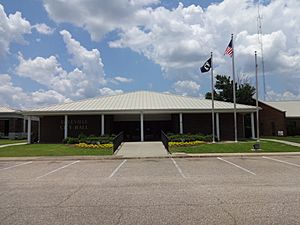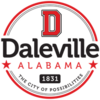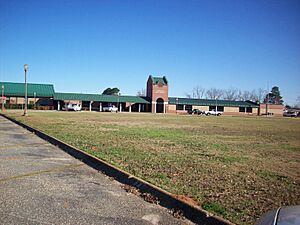Daleville, Alabama facts for kids
Quick facts for kids
Daleville
|
|||
|---|---|---|---|
|
City
|
|||

Daleville City Hall
|
|||
|
|||
| Nickname(s):
Gateway to Fort Rucker
|
|||

Location of Daleville in Dale County, Alabama.
|
|||
| Country | United States | ||
| State | Alabama | ||
| County | Dale | ||
| Area | |||
| • Total | 14.14 sq mi (36.63 km2) | ||
| • Land | 14.14 sq mi (36.63 km2) | ||
| • Water | 0.00 sq mi (0.00 km2) | ||
| Elevation | 331 ft (101 m) | ||
| Population
(2020)
|
|||
| • Total | 4,866 | ||
| • Density | 344.06/sq mi (132.84/km2) | ||
| Time zone | UTC-6 (Central (CST)) | ||
| • Summer (DST) | UTC-5 (CDT) | ||
| ZIP code |
36322
|
||
| Area code(s) | 334 | ||
| FIPS code | 01-19360 | ||
| GNIS feature ID | 0117016 | ||
Daleville is a city in Dale County, Alabama, United States. In 2010, about 5,295 people lived there. This was more than the 4,653 people in 2000. It is part of the Ozark Micropolitan Statistical Area. The city is known as the "Gateway to Fort Rucker". This is because a big U.S. Army base is just north of town. Cairns Army Airfield is also nearby, south of Daleville.
Contents
History of Daleville
Daleville started in 1827. It was first called "Dale's Court House". People who fought in the Creek Indian War settled here. Daleville was the first main town, or county seat, for Dale County in 1827. But in 1841, Coffee County became its own county. So, the county seat moved to Newton, then to Ozark in 1870. Ozark is still the county seat today.
The name Daleville was chosen in 1848. The town voted to become an official city in 1912. But they changed their minds in 1916. Later, in 1958, they voted again to become an official city.
Daleville and the Civil War
During the U.S. Civil War, some people from Daleville joined the Confederate States Army. They were part of two groups of soldiers. One group, the 15th Alabama Infantry, was famous. They fought bravely at Little Round Top during the Battle of Gettysburg.
Another group was the 33rd Alabama Infantry. Company "G" of this group was called the "Daleville Blues". All its members were from Daleville. Some of these soldiers died in a train accident in 1862. The rest fought until the war ended in 1865.
Growth of the City
For a long time, Daleville was a small farming town. But it grew a lot in the mid-1900s. This happened because Fort Novosel (then called Fort Rucker) became a big U.S. Army base. It's where the Army trains its pilots.
A former mayor, Douglas Brown, worked with two businessmen. They bought land in Daleville and built homes and shops. Many military families moved to Daleville. After their service, many soldiers chose to stay. This is why Daleville has a more diverse population than other towns nearby.
Tornado in 2001
On November 24, 2001, an F1 tornado hit Daleville. It was part of a larger storm system. Two restaurants and two industrial buildings were destroyed. Many other businesses, a church, and homes were also damaged. About 25 people were hurt, but thankfully, no one died.
Geography of Daleville
Daleville is in the southwest part of Dale County. Its exact location is 31°18′9″N 85°42′40″W / 31.30250°N 85.71111°W. U.S. Highway 84 goes through the southern part of the city. This highway goes east to Dothan (about 21 miles) and west to Enterprise (about 10 miles).
Alabama State Route 85 starts in Daleville. It goes south for about 23 miles to Geneva. This road crosses U.S. Highway 84 in Daleville. Alabama State Route 134 goes east from Daleville for about 7 miles toward Newton. If you go west on Route 134, it joins U.S. 84 to Enterprise.
The U.S. Census Bureau says Daleville covers about 36.5 square kilometers (14.1 square miles). All of this area is land. The Choctawhatchee River flows a few miles east of the city.
Population Information
| Historical population | |||
|---|---|---|---|
| Census | Pop. | %± | |
| 1960 | 693 | — | |
| 1970 | 5,182 | 647.8% | |
| 1980 | 4,250 | −18.0% | |
| 1990 | 5,117 | 20.4% | |
| 2000 | 4,653 | −9.1% | |
| 2010 | 5,295 | 13.8% | |
| 2020 | 4,866 | −8.1% | |
| U.S. Decennial Census 2013 Estimate |
|||
2010 Census Details
In 2010, there were 5,295 people living in Daleville. There were 2,384 households, which are groups of people living together. About 25% of households had children under 18. The average household had 2.22 people.
The people in Daleville came from different backgrounds:
- 66.2% White
- 22.6% Black or African American
- 1.1% Native American
- 2.7% Asian
- 2.9% from other races
- 4.3% from two or more races
- 10.1% of the people were Hispanic or Latino.
The median age in Daleville was 35 years old. This means half the people were younger than 35, and half were older.
2020 Census Details
| Race | Num. | Perc. |
|---|---|---|
| White (non-Hispanic) | 2,663 | 54.73% |
| Black or African American (non-Hispanic) | 1,108 | 22.77% |
| Native American | 22 | 0.45% |
| Asian | 152 | 3.12% |
| Other/Mixed | 358 | 7.36% |
| Hispanic or Latino | 563 | 11.57% |
As of the 2020 United States census, there were 4,866 people living in the city. There were 1,965 households and 1,203 families.
Schools in Daleville
Daleville has its own school system with two schools. [Windham Elementary School] teaches students from kindergarten to 6th grade. [Daleville High School] teaches students from 7th to 12th grade.
The high school's JROTC program is very good. It has been rated "Honor Unit With Distinction" for many years. This is the highest possible rank for a JROTC unit. The high school's rifle team has won seventeen state championships. The football team won the state championship in 1992 and was second in 1993. In 1997, the high school basketball team made it to the state's final four tournament.
Notable People from Daleville
- Mickey Andrews, college football coach
- Ethel Cain, singer-songwriter
- Jonas Randolph, American football player
- Tony Richardson, NFL player
- Robert W. Smith, composer
- Shawn Stuckey, NFL player and attorney
- Margaret Peterlin, a high-ranking government official
See also
 In Spanish: Daleville (Alabama) para niños
In Spanish: Daleville (Alabama) para niños





